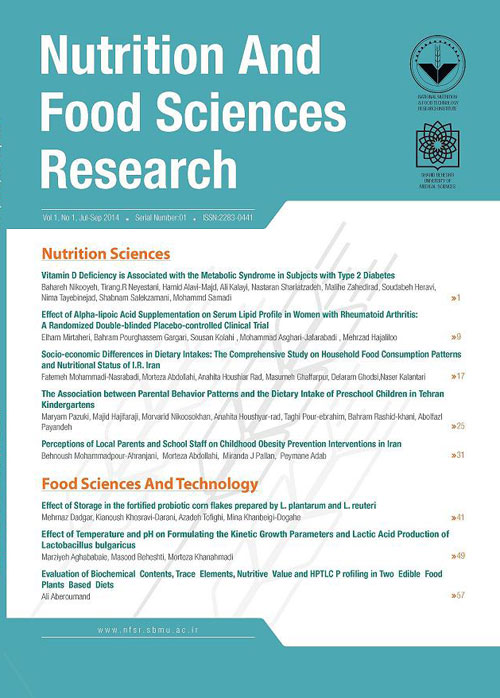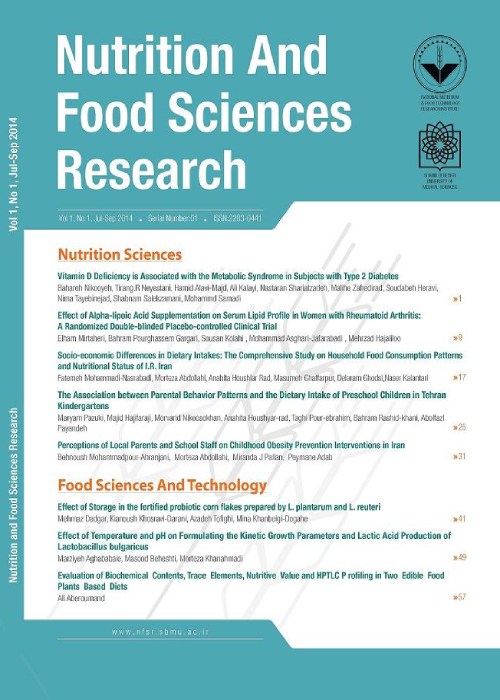فهرست مطالب

Nutrition & Food Technology Research
Volume:4 Issue: 3, Jul-Sep 2017
- تاریخ انتشار: 1396/06/08
- تعداد عناوین: 6
-
-
Pages 3-10Background And ObjectivesFood insecurity has some adverse effects on health. Studies show that, there is a significant relationship between poor mental and physical health and food insecurity among low-income households. The purpose of this study is to investigate the relationship between household food insecurity and physical and mental health in Iranian women with high school age children.Materials And MethodsThis cross-sectional study was conducted on 289 women with high school aged children in Babolsar, Iranin spring 2015. General Information Questionnaire, 18-item USDA household food security questionnaires and health survey (SF-12) was completed by face-to-face interviews with the participants. The mental and physical health of the participants were compared based on food secure and food insecure group.ResultsFood insecurity was significantly related to age of the participants, living area (urban/rural), husbands job and education of women studied (pConclusionsTherefore, household food insecurity is an independent risk factor for poor mental and physical health in women with high school aged children. The findings of this research provide insights for the future as the crucial role of woman and their significant impact on food security and the health status of the household can be used to develop targeted interventions aimed at women with children.Keywords: Food insecurity, Mental health, Physical health, Woman
-
Pages 11-17Background And ObjectivesMicrobial activity is the main factor in spoiling food products, which not only changes their texture and taste but also causes economic damage and poisoning. The present study aimed to assess the effects of essential oil of Bane (Pistacia atlantica) on physico-mechanical and antimicrobial properties of gelatin- carboxymethyl cellulose film.Materials And MethodsThe solutions (4% w/v) of gelatin and CMC (1% w/v) were prepared in deionized water.
Then different levels of essential oil (0, 03%, 0.6%, and 0.8%) were added to the solutions. Then the films were prepared by casting. The methods of physico-mechanical and antimicrobial evaluation were done based on previous research.ResultsThe results showed significant reduction in water vapor permeability, the thickness of film, tensile strength and solubility by increasing essential oil, while the percentage increased (PConclusionsEssential oil of Bane improved the mechanical properties and inhibitory effects in regards to growth of microorganisms.Keywords: Edible Film, Gelatin, Bane, Antimicrobial Features, Essential Oil -
Pages 19-28Background And ObjectivesStudies on packaged food by activated biopolymer starch films containing antimicrobial material is interesting field of food. Science This study investigates the effect of chitosan and rosemary essential oil on properties of starch films and peanut were packaged in them.Materials And MethodsIn this study, composite films based on starch containing 0, 2, 4, 6 and 8% chitosan and values of 0, 0.5, 1, 1.5 and 2 % rosemary essential oil produced by casting method, peanut packaging in them and the growth of Aspergillus flavus and aflatoxin B1 production were investigated up to 12 days; as well as, the optimal point and regression model with RSM, Minitab 17.ResultsResults of films showed chitosan and rosemary had decreasing effect on water vapor permeability, solubility and moisture absorption and increasing effect on tensile strength. The optimal point for physical properties of film was proposed 2% rosemary and 7.27% chitosan. In addition, the film reduced number of Aspergillus flavus about 4700 cfu/g, both chitosan and rosemary had a significant effect in this respect, although rosemary effect was more. The decreasing effect in the production of aflatoxin was found. The microbial optimal condition for film with 2% rosemary and 4% chitosan was created after 12 days, which showed the antimicrobial effect of film over time.ConclusionsIt seems, rosemary has a major variable to improve physical and microbial properties of the films, while, chitosan has significant effect on physical properties.Keywords: Rosemary essential oil, Aspergillus flavus, Aflatoxin, Peanut, Starch-chitosan biopolymer
-
Pages 29-38Background And ObjectivesOne of the problems in juice membrane clarification is the accumulation and deposition of rejected compounds on membrane surfaces or inside its pores which results in a membrane fouling.Materials And MethodsSeveral parameters can have influence on fouling in one hand and prediction of juice permeates flux during the membrane processing is of importance in industrial applications on the other hand. Therefore, providing a model able to predict the permeate flux having the value of effective input parameters seems to be useful. In this regard, several artificial methods can be used. In contrast, the Fuzzy Inference System (FIS) has been proposed as a reliable and appropriate machine learning method to predict the output parameter with acceptable performance. In this study, a FIS will be used to model the permeate flux based on five input variables: the transmitted membrane pressure, feed flow rate, processing time, membrane pore size, and membrane type. For this purpose, a fuzzy system is trained using the laboratory data and then, appropriate membership functions for the input and output variables and fuzzy rules are extracted for the proper prediction of permeate flux.ResultsResults were shown that the normalized mean squared errors for the prediction of permeate flux in the membrane processing are 0.0055 and 0.0081 for the Mixed Cellulose Ester (MCE) and the Polyvinylidene Flouride (PVDF) membranes, respectively.ConclusionsIn total, the fuzzy inference model which is presented in this study has been able to predict the pomegranate juice permeate flux with an acceptable error compared with the laboratory data.Keywords: Pomegranate Juice, Clarification, Membranes Process, Fuzzy Inference System
-
Pages 39-46Background And ObjectivesConsumption of whole dairy products has declined due to the awareness of possible harmful effects of fat on consumers health. The purpose of the present paper was to investigate the possibility of substituting the Ultra-high temperature processing (UHT) whole milk with partially hydrolyzed κ-casein to manufacture a UHT skim milk.Materials And MethodsUHT skim milk samples were prepared using 0.2, 0.4, 0.6 and 0.8 % (w/w) of rennet followed by storage at 60°C for 15 minutes to inactivate the enzyme. The Chemical, physical and sensory characteristics of control and treated samples were evaluated. Statistical analysis was performed by SPSS.ResultsThe results showed that a higher concentration of rennet increased and decreased b* (blueyellow) and a* (greenred), respectively (pConclusionsThe result showed that, RSM4 (Renneted UHT skim milk with 0.3% fat and 0.8 % (w/w) rennet) has similar characteristics to whole milk and it is also clear in viscosity and sensory evaluation among other samples. It has been noted that non-dairy components were not used in RSM4 and the new production can be a very functional and safe fat mimetic by merely changing the structure of casein micelles.Keywords: UHT milk, Rennet skim milk, Fat mimetics, Healthy food


